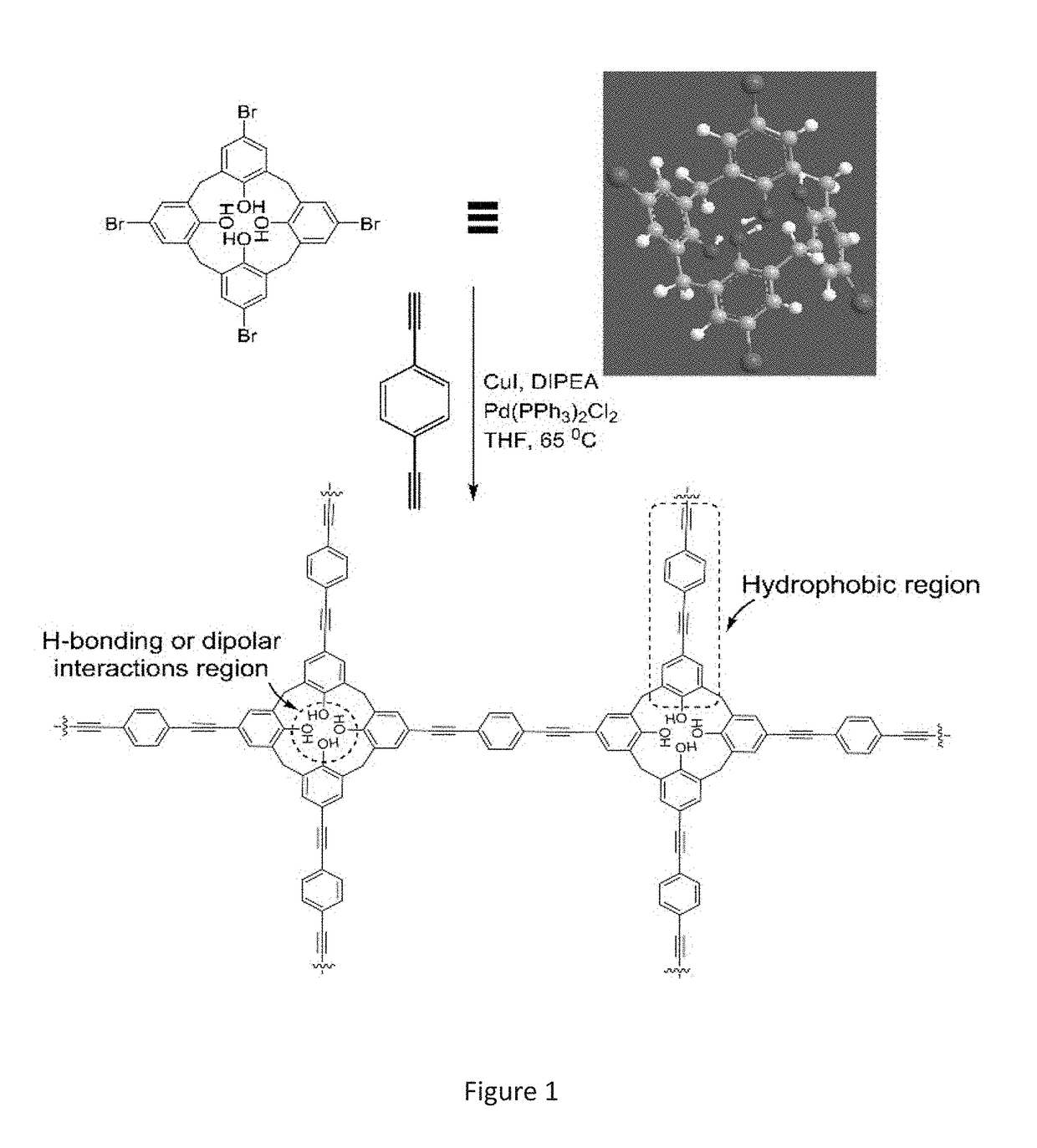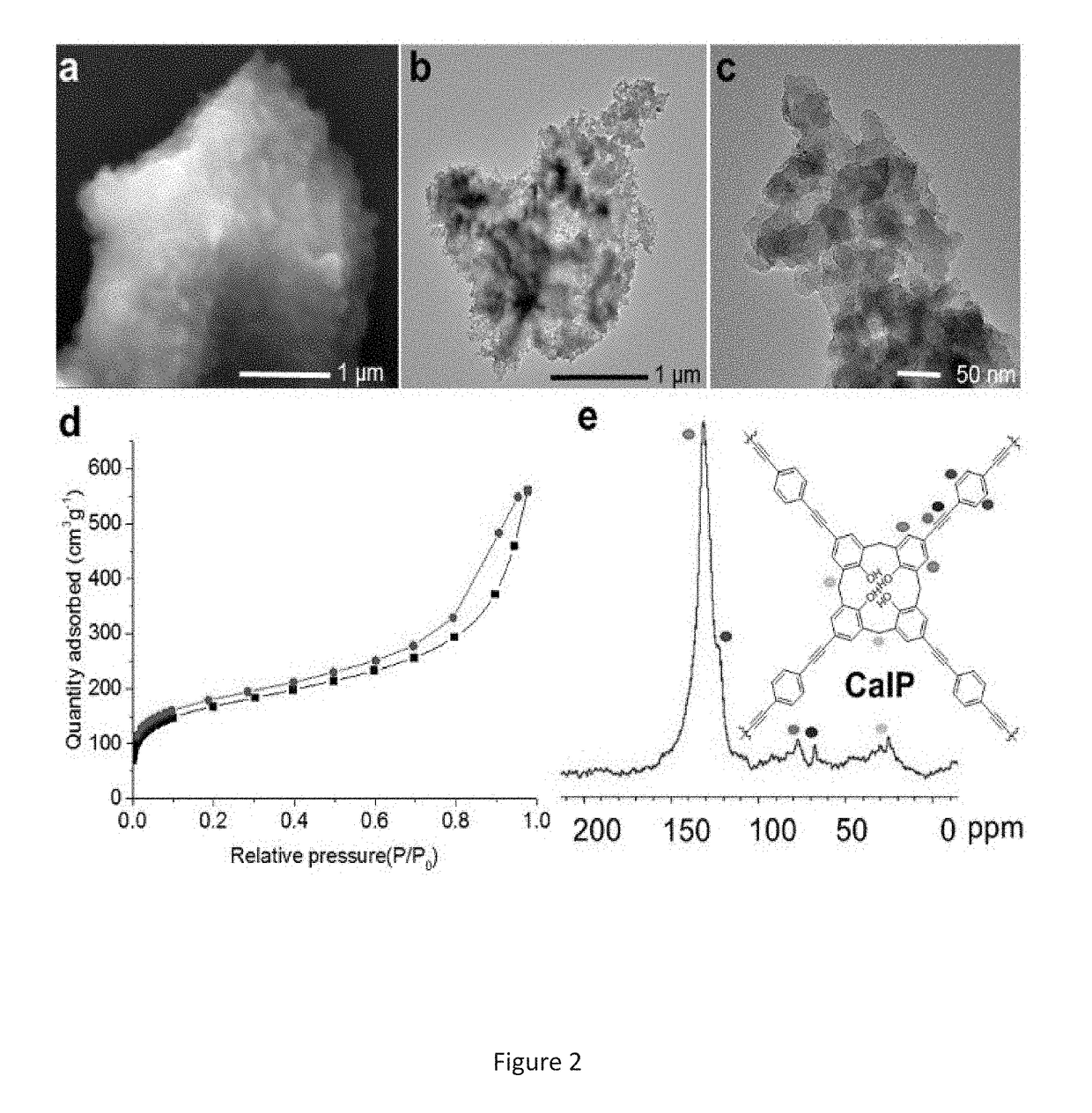Polycalixarene materials, methods of making same, and uses thereof
- Summary
- Abstract
- Description
- Claims
- Application Information
AI Technical Summary
Benefits of technology
Problems solved by technology
Method used
Image
Examples
example 1
[0157]This example provides a description of preparation, characterization and use of polycalixarenes of the present disclosure.
[0158]In this example, we describe the preparation of a porous covalent polycalixa[4]arene (CalP) and its use for the removal of organic solvents, oil and toxic dyes from aqueous mixtures. (FIG. 5).
[0159]Calix[n]arenes (n=4, 6, 8) are cyclic phenolic oligomers. They possess a hydrophobic cavity that has both polar and non-polar rims for guest recognition. Also, they can be selectively modified to provide analyte-selectivity or to facilitate incorporation into larger structures. Disclosed is attaching calixarenes on the backbone of a polymeric network to an absorbant material.
[0160]The Sonogashira-Hagira reaction was chosen as a convenient means for crosslinking brominated calixarenes. This method brought with it the additional benefits of, such as, for example, alkyne functionality. Alkynes are known to endow materials with, such as, for example, high surfa...
example 2
[0175]This example provides a description of preparation, characterization of polycalixarenes, and their use for ultrafast removal of organic micropollutants from water.
[0176]A series of calix[4]arene-based porous materials (CalPn's, n=2, 3, and 4) were synthesized and used as an efficient adsorbents to remove organic micropollutants from water. These materials exhibit excellent adsorption efficiencies and fast adsorption kinetics for range of micropollutants through multiple sorption sites. CalP4, one of the materials developed in current study removed Bisphenol A with the fastest rate than all other tested adsorbents with ˜70% removal within 30 sec and reached equilibrium within 15 min with a removal efficiency of ˜80%. It also removed ˜82% of propranolol within 30 sec of contact and reached equilibrium in 20 min with a removal efficiency of ˜91%. The adsorption rate constant (kobs) for bisphenol A adsorption is 2.12 mg g−1 min−1 and for propranolol adsorption is 1.75 mg g−1 min−1...
example 3
[0204]This example provides a description of preparation, characterization and use of porous polymeric materials of the present disclosure.
[0205]A series of porous π-electron rich polymers containing calix[4]arene were synthesized by palladium catalyzed Sonogashira-Hagihara crosscoupling reactions of tetrabromocalix[4]arene and several alkyne-modified aryl linkers. The calixarenes of the polymers were lithiated at their lower rims to form charged polymeric networks. Both neutral and charged networks exhibited high affinities for solution and vapor phase iodine owing to the presence of a combination of non-polar and polar sorption sites. Lithiation of the polymers enhanced iodine uptake rate and capacity. The lithiated polymer CalP4-Li exhibited one of the highest iodine uptake capacities (312% w / w) ever measured in just 30 min. All polymers were easily regenerated by mild ethanol washings and could be reused with negligible loss of efficiency. Polymeric networks such as these may be...
PUM
| Property | Measurement | Unit |
|---|---|---|
| Fraction | aaaaa | aaaaa |
| Angle | aaaaa | aaaaa |
| Angle | aaaaa | aaaaa |
Abstract
Description
Claims
Application Information
 Login to View More
Login to View More - Generate Ideas
- Intellectual Property
- Life Sciences
- Materials
- Tech Scout
- Unparalleled Data Quality
- Higher Quality Content
- 60% Fewer Hallucinations
Browse by: Latest US Patents, China's latest patents, Technical Efficacy Thesaurus, Application Domain, Technology Topic, Popular Technical Reports.
© 2025 PatSnap. All rights reserved.Legal|Privacy policy|Modern Slavery Act Transparency Statement|Sitemap|About US| Contact US: help@patsnap.com



